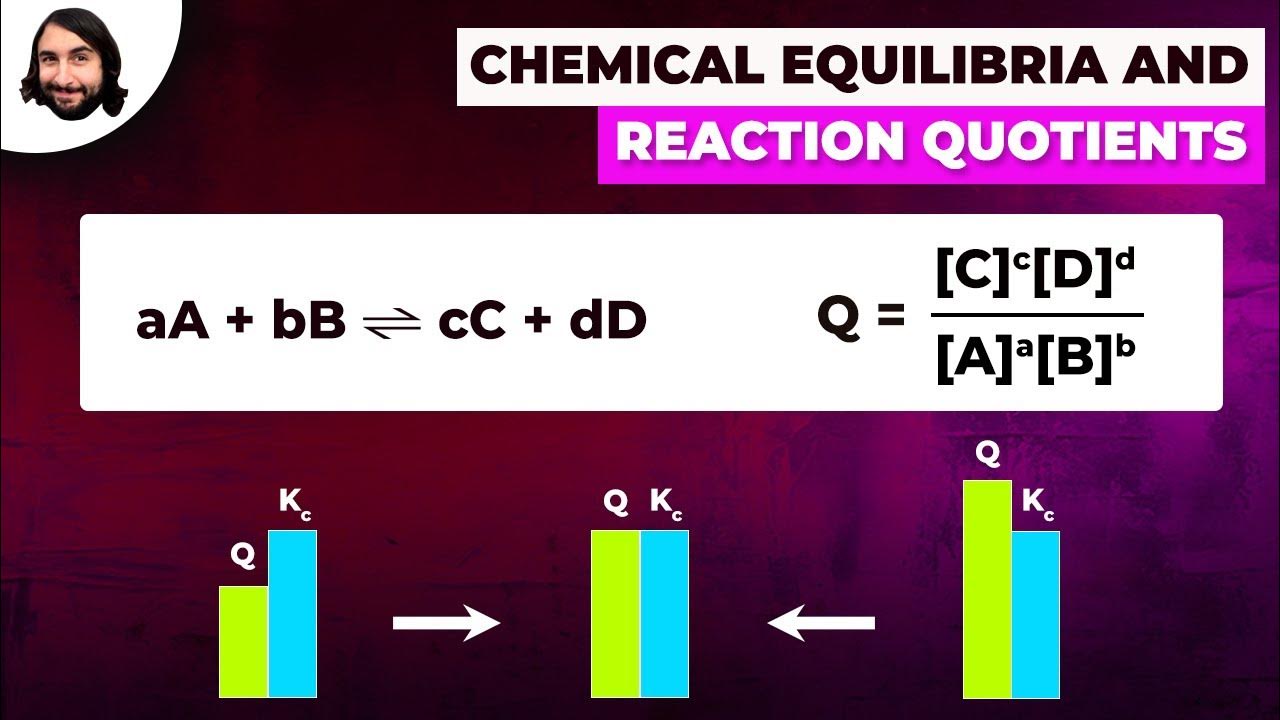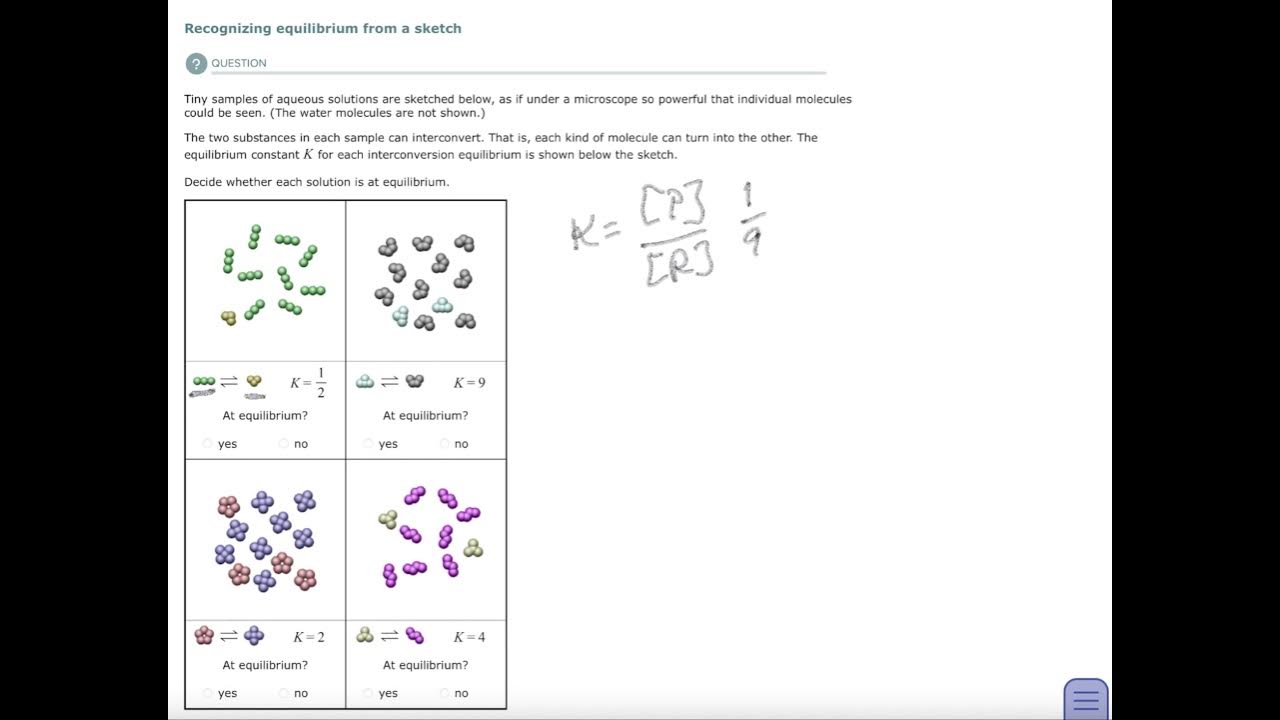ALEKS: Predicting relative forward and reverse rates of reaction in dynamic equilibrium
TLDRThis educational video tutorial explains how to tackle an Aleks chemistry problem involving predicting the rates of forward and reverse reactions in a dynamic equilibrium system. The instructor begins by clarifying the concept of equilibrium and the significance of the reaction direction. The scenario involves adding 99 millimoles of H2 and Cl2 to a flask, leading to the formation of HCl. The video addresses four key questions, focusing on the initial rate of the forward reaction, its rate after adding reactants, the rate at equilibrium, and the final amount of H2 remaining. The instructor emphasizes that at equilibrium, the forward and reverse reaction rates are equal, and some H2 will be consumed but not all.
Takeaways
- 🧪 The video discusses solving an Aleks problem related to predicting forward and reverse reaction rates in a dynamic equilibrium.
- 🔍 The problem involves a chemical reaction with two reactants, H2 and Cl2, and the reaction is in equilibrium despite not using equilibrium arrows.
- ⚖️ The script explains that 99 millimoles of H2 and Cl2 are added to an empty flask, indicating no initial presence of HCl.
- ⏱ The first question asks about the rate of the forward reaction before any H2 or Cl2 has been added, which would be zero since there are no reactants.
- 🚀 After adding H2 and Cl2, the forward reaction rate is greater than zero, indicating the reaction will proceed quickly to produce HCl.
- ⚖️ The rate of the forward reaction is expected to be greater than the rate of the reverse reaction initially, as the system tries to accumulate HCl.
- 🔄 At equilibrium, the rates of the forward and reverse reactions are equal, a defining characteristic of dynamic equilibrium.
- ⚠️ The script clarifies that the rate of the forward reaction at equilibrium is greater than zero and equal to the rate of the reverse reaction.
- 📉 At equilibrium, not all of the initial 99 millimoles of H2 will have been used, leaving some amount greater than zero but less than 99 millimoles.
- 📚 The video script serves as an educational guide to understanding reaction rates and equilibrium in chemistry.
- 📉 The final state of the system at equilibrium involves a balance where some of the initial reactants remain unconverted.
Q & A
What is the topic of the video?
-The video is about solving an Aleks problem that involves predicting the relative forward and reverse rates of a chemical reaction in dynamic equilibrium.
What does the video claim about the chemical reaction presented?
-The video claims that the chemical reaction is in equilibrium, even though equilibrium arrows are not used in the problem statement.
What is the initial condition of the reaction system in the problem?
-The initial condition is that 99 millimoles of H2 and Cl2 are added to an empty flask, meaning there is no HCl present initially.
What does the term 'forward reaction' refer to in the context of the video?
-In the context of the video, 'forward reaction' refers to the reaction proceeding from left to right as written in the chemical equation.
What is the rate of the forward reaction before any H2 or Cl2 has been added?
-The rate of the forward reaction before any H2 or Cl2 has been added is zero, as there are no reactants present to initiate the reaction.
After adding H2 and Cl2, what can be said about the rate of the forward reaction?
-After adding H2 and Cl2, the rate of the forward reaction is greater than zero because the system will attempt to produce HCl, proceeding quickly in the forward direction.
What is the relationship between the rates of the forward and reverse reactions at equilibrium?
-At equilibrium, the rates of the forward and reverse reactions are equal to each other.
What is the expected amount of H2 remaining in the flask at equilibrium?
-At equilibrium, some amount of the initial 99 millimoles of H2 will have been used up, so the amount remaining will be greater than zero but less than 99 millimoles.
Why is it incorrect to say that the rate of the forward reaction after adding H2 and Cl2 is equal to the rate of the reverse reaction?
-It is incorrect because initially, the reaction will proceed quickly in the forward direction to accumulate HCl, and the forward reaction rate will be greater than the reverse reaction rate until equilibrium is reached.
What does the video imply about the reaction rate after the addition of H2 and Cl2 but before reaching equilibrium?
-The video implies that the reaction rate in the forward direction will be significantly greater than zero and will be faster than the reverse reaction rate as the system tries to establish equilibrium.
How does the video script guide the viewer to understand the concept of dynamic equilibrium in chemical reactions?
-The video script guides the viewer by explaining the initial conditions, the direction of reactions, and how the rates of forward and reverse reactions relate to each other, emphasizing that at equilibrium these rates are equal.
Outlines
🔍 Introduction to Predicting Reaction Rates
This paragraph introduces a video tutorial on solving an Aleks problem about predicting the relative forward and reverse rates of a chemical reaction in dynamic equilibrium. The problem involves a reaction with two reactants, and the video will explain how to approach the questions related to the reaction rates and equilibrium. The chemical equation is rewritten with equilibrium arrows for clarity, and the initial conditions of the problem are set: 99 millimoles of H2 and Cl2 are added to an empty flask, with no initial HCl present.
📚 Understanding Forward Reaction Rates
The paragraph delves into the concept of forward reaction rates, explaining that the rate of the forward reaction is the speed at which reactants are converted into products. Initially, before any H2 or Cl2 is added, there is no reaction occurring, and thus the rate is zero. After adding H2 and Cl2, the system starts to produce HCl, and the forward reaction rate increases. The video clarifies that the rate of the forward reaction after adding reactants is greater than zero and greater than the rate of the reverse reaction, as the system is trying to accumulate HCl. The rate of the forward reaction at equilibrium is equal to the rate of the reverse reaction, which is a fundamental principle of dynamic equilibrium.
🧪 Equilibrium and Remaining Reactants
This part of the script discusses the concept of equilibrium in the context of the chemical reaction. At equilibrium, the rates of the forward and reverse reactions are equal, ensuring that the concentrations of reactants and products remain constant. The video concludes with a question about the amount of H2 remaining in the flask at equilibrium. It is explained that not all of the 99 millimoles of H2 will be used up, and some amount greater than zero but less than 99 will remain, indicating that the reaction has reached a dynamic balance where the forward and reverse reactions are occurring at the same rate.
Mindmap
Keywords
💡Dynamic Equilibrium
💡Chemical Reaction
💡Equilibrium Arrows
💡Reactants
💡Products
💡Forward Reaction
💡Reverse Reaction
💡Rate of Reaction
💡Millimoles
💡Empty Flask
💡Equilibrium
Highlights
The video explains how to solve a problem about predicting relative forward and reverse rates of a reaction in dynamic equilibrium.
The problem involves a chemical reaction in equilibrium, with quantities of reactants given.
The chemical equation is rewritten with equilibrium arrows for clarity.
99 millimoles of H2 and Cl2 are added to an empty flask, with no initial HCl present.
The rate of the forward reaction before any H2 or Cl2 has been added is zero.
After adding H2 and Cl2, the reaction proceeds quickly in the forward direction to produce HCl.
The rate of the forward reaction after adding H2 and Cl2 is greater than zero and faster than the reverse reaction initially.
At equilibrium, the rates of the forward and reverse reactions are equal.
The rate of the forward reaction at equilibrium is greater than zero and equal to the rate of the reverse reaction.
At equilibrium, some amount of H2, greater than zero but less than 99 millimoles, will be in the flask.
The initial reaction rate is zero because there are no reactants present before adding H2 and Cl2.
The reaction quickly moves to produce HCl when H2 and Cl2 are added, indicating a rapid forward reaction.
The system attempts to reach equilibrium by balancing the forward and reverse reaction rates.
The equilibrium state is characterized by equal rates of forward and reverse reactions.
The amount of H2 remaining at equilibrium is less than the initial 99 millimoles, indicating some has been consumed in the reaction.
The video provides a clear explanation of how to approach problems involving dynamic equilibrium in chemical reactions.
Transcripts
Browse More Related Video
5.0 / 5 (0 votes)
Thanks for rating:





